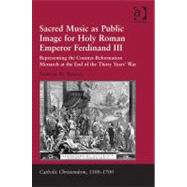Sacred Music as Public Image for Holy Roman Emperor Ferdinand III: Representing the Counter-Reformation Monarch at the End of the Thirty Years' War
, by Weaver,Andrew H.- ISBN: 9781409421191 | 1409421198
- Cover: Hardcover
- Copyright: 6/20/2017
Ferdinand III played a crucial role both in helping to end the Thirty Years' War and in reestablishing Habsburg sovereignty within his crown lands. The foundation laid by Ferdinand at this particularly crucial time in European history contributed significantly to the reemergence of the Habsburgs as political and cultural leaders under such later rulers as Leopold I, Charles VI, and Maria Theresa. The underlying premise of this book is that Ferdinand III accomplished this not through diplomacy or strong leadership but primarily through a skillful manipulation of the arts, through which he communicated important messages to his subjects and secured their allegiance to the Catholic church.The war necessitated that the emperor revise the image he had cultivated at the beginning of his reign, that of a powerful, victorious warrior. Ferdinand never ceased his lavish patronage of music, maintaining, through even the most difficult years of the war, a large musical establishment featuring some of the most famous musicians in Europe. Weaver argues that by focusing on the patronage of sacred music, Ferdinand III was able to uphold his reputation as a pious Catholic reformer and subtly revise his triumphant martial image without sacrificing his power, while also achieving his Counter-Reformation goal of unifying his crown lands under the Catholic church.Drawing upon recent methodological approaches to the representation of other early modern monarchs as well as upon the theory of confessionalization, this book places the sacred vocal music composed by imperial musicians into the rich cultural, political, and religious contexts of mid-seventeenth-century Central Europe. The book incorporates dramatic productions such as opera, oratorio, and Jesuit drama (as well as works in other media), but the primary focus is the more numerous and more frequently performed Latin-texted liturgical and paraliturgical genres of mass and motet, works that have generally not been considered by scholars as vehicles for monarchical representation. By examining the representation of this little-studied emperor during a crucial time in European history, this book opens a window into the unique world view of the Habsburgs, allowing for a previously untold narrative of the end of Thirty Years' War as seen through the eyes of this important ruling family.







